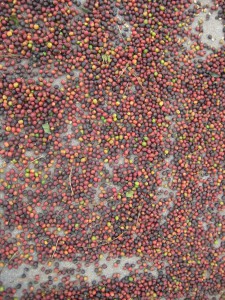“Bird Friendly” Brew: Honduran Shade-Grown Coffee
While Studying the Golden-winged Warbler in Honduras, CWF Biologist Learned about “Bird Friendly” Coffee
by Kelly Triece, Private Lands Biologist

Did you enjoy a warm cup of coffee this morning? I know I did. Over 2.25 billion cups of coffee are consumed every day.
Coffee is also one of the world’s top agricultural exports in many developing countries. While I was in Honduras, with the Pennsylvania Golden-winged Warbler working group, I was given the opportunity to visit a shade grown coffee farm!
As I traveled across the country, I was able to enjoy many fresh cups of local Honduran coffee and learn about the importance of coffee as part of the Honduran history and local economy.
In 2011, Honduras became the number one coffee producer in Central America. Today, there are over 100,000 registered coffee producers in the country and over 90% of them are small producers. Coffee has become a vital part of the Honduran economy and family system, helping to generate small businesses and bring revenue to the local community.

In Honduras, coffee is harvested from November to March every year. Coffee is hand-picked and resembles a green or red cherry fruit when ripe. After ripening and picking, coffee must be dried and the outer coating, called the parchment, or pergamino must be removed. There are various methods of parchment removal and drying. Different drying and roasting techniques give way to differing quality, taste and aroma.
In its wild form, coffee is a small tree or shrub that grows in the understory of a forest. Traditionally, coffee production occurs on large farm fields, where the land is tilled and little native vegetation grows. Coffee producers often use this traditional method as a way to increase yield and fight off diseases susceptible to the plant. Recently, however, coffee producers have begun to grow shade-tolerant coffee which is grown under a forest canopy.
Shade-tolerant coffee production is a method which intends to incorporate the natural principles of ecology into agricultural production. Shade tolerant or shade-grown coffee is grown under a natural forest canopy. Shade grown coffee can have multiple benefits — reducing pests, increasing pollination and creating important wildlife habitat. Shade grown coffee plantations often have increased leaf litter which reduces erosion and allows for improved water quality.

Through the incorporation of native trees on farms, birds and natural predators will help reduce pest insects, which in turn, helps reduce the need for pesticides. Bird diversity is often higher on shade grown coffee farms since they eat the fruit, insects and nectar in the native tree canopy. These types of farming practices have also be termed “bird friendly” coffee, because they help support local bird populations, including migratory birds that stay in Honduras during their wintering months.

Upon our visit to a shade-grown coffee farm, called Lenca farms in the little town of Marcala, we were greeted with a Golden-winged Warbler! Most of the farm grew coffee right under the native forest canopy. Many of the native trees, leaf litter and herbaceous plants were left intact. It was great to meet with local Honduran farmers, who are eager to create and maintain wildlife habitat on their farms. Many Hondurans recognize the value in wildlife and are willing participants in wildlife conservation.
Shade-grown coffee may be important as coffee continues to be a growing commodity crop worldwide. When farmers learn to grow food in conjunction with nature, not against it, the best yields and benefits for the environment can result.
We were very appreciate of our time a Lenca Farms, and we didn’t leave without a fresh cup right on site!
Check out Smithsonian Migratory Bird Center online to learn about the certification process for coffee farms called “Bird Friendly Coffee” and to learn how to buy bird friendly coffee!
Learn More:
- CWF Headed to Honduras to Study Golden-winged Warbler
- Conserve Wildlife Foundation’s online field guide: Golden-winged Warbler
Kelly Triece is the Private Lands Biologist for Conserve Wildlife Foundation of New Jersey.
Discover more from Conserve Wildlife Foundation of NJ
Subscribe to get the latest posts sent to your email.